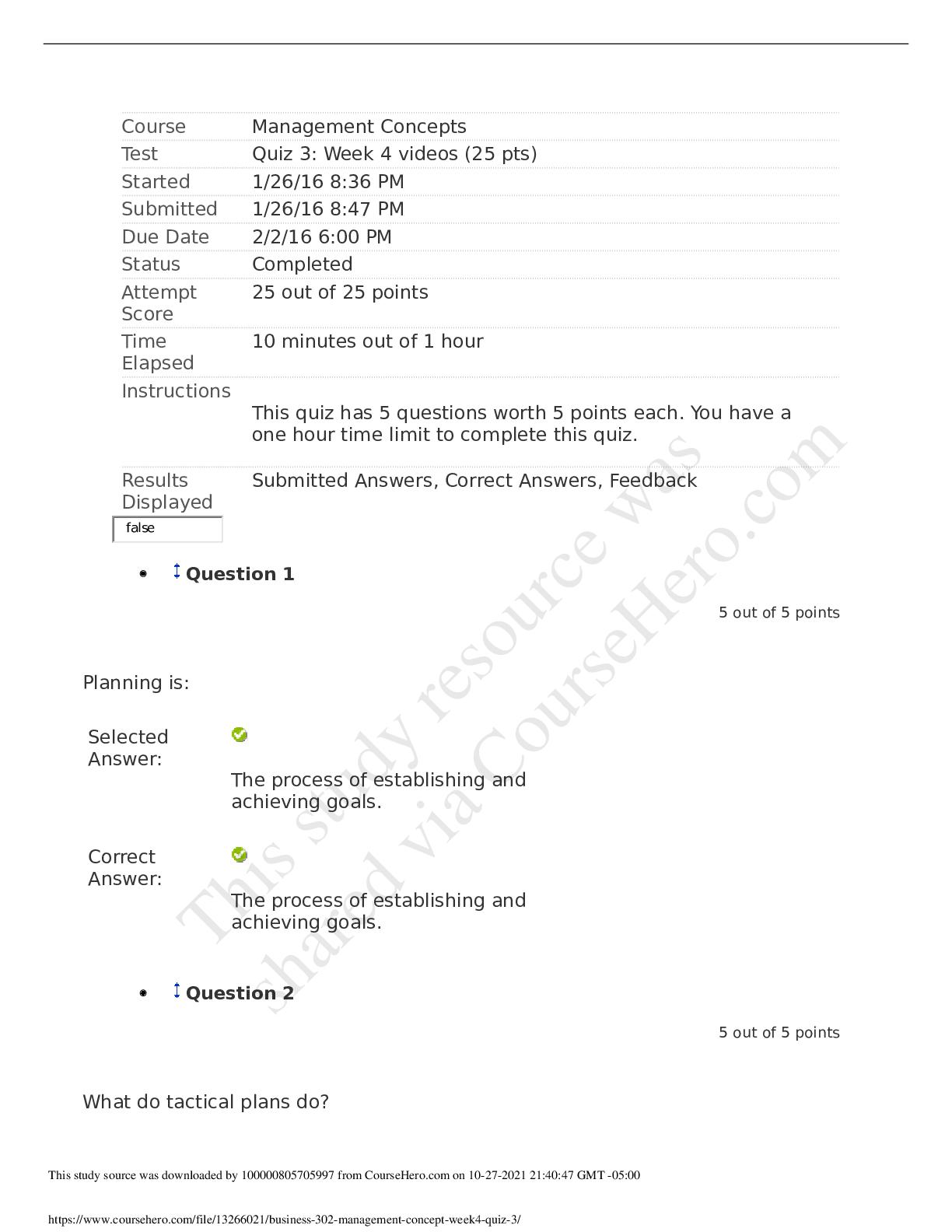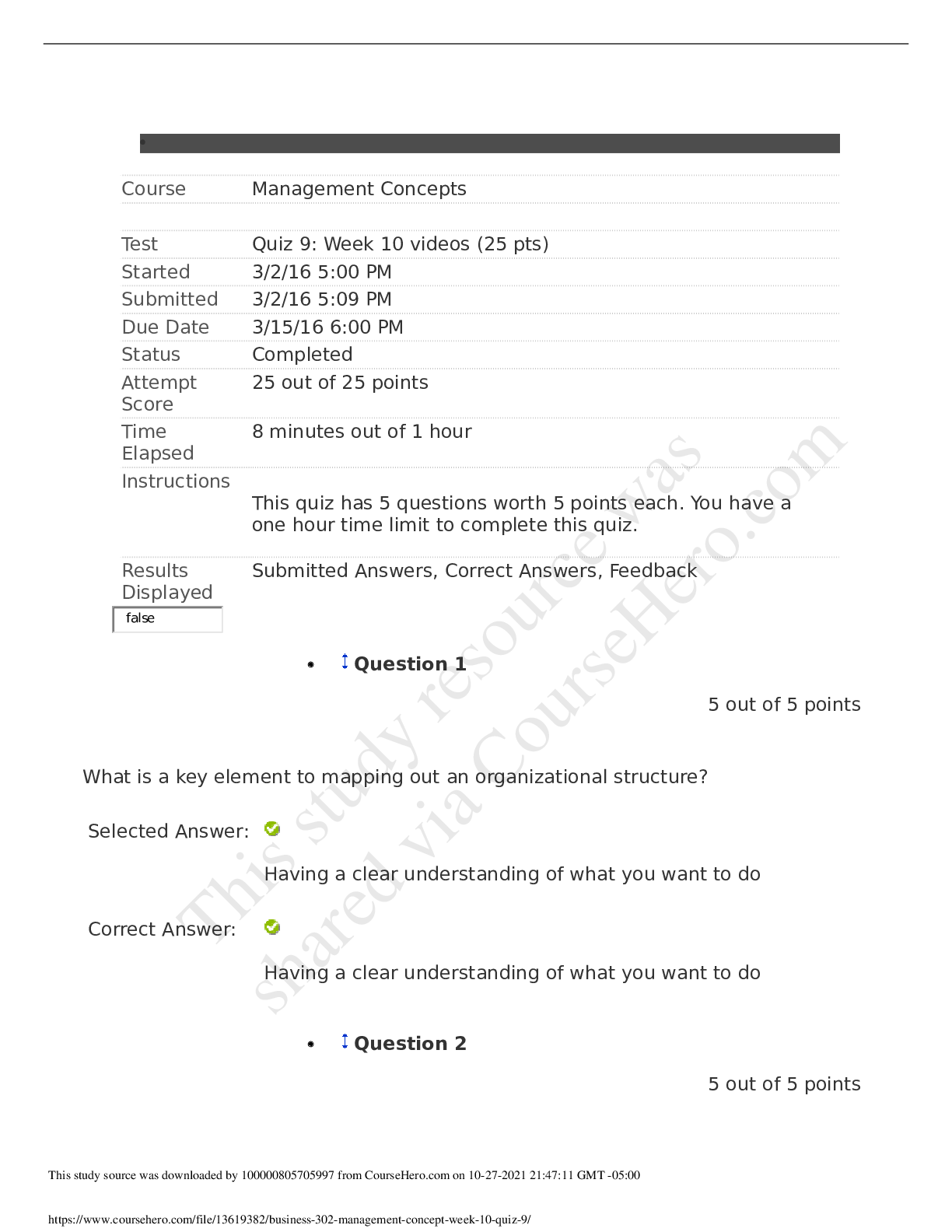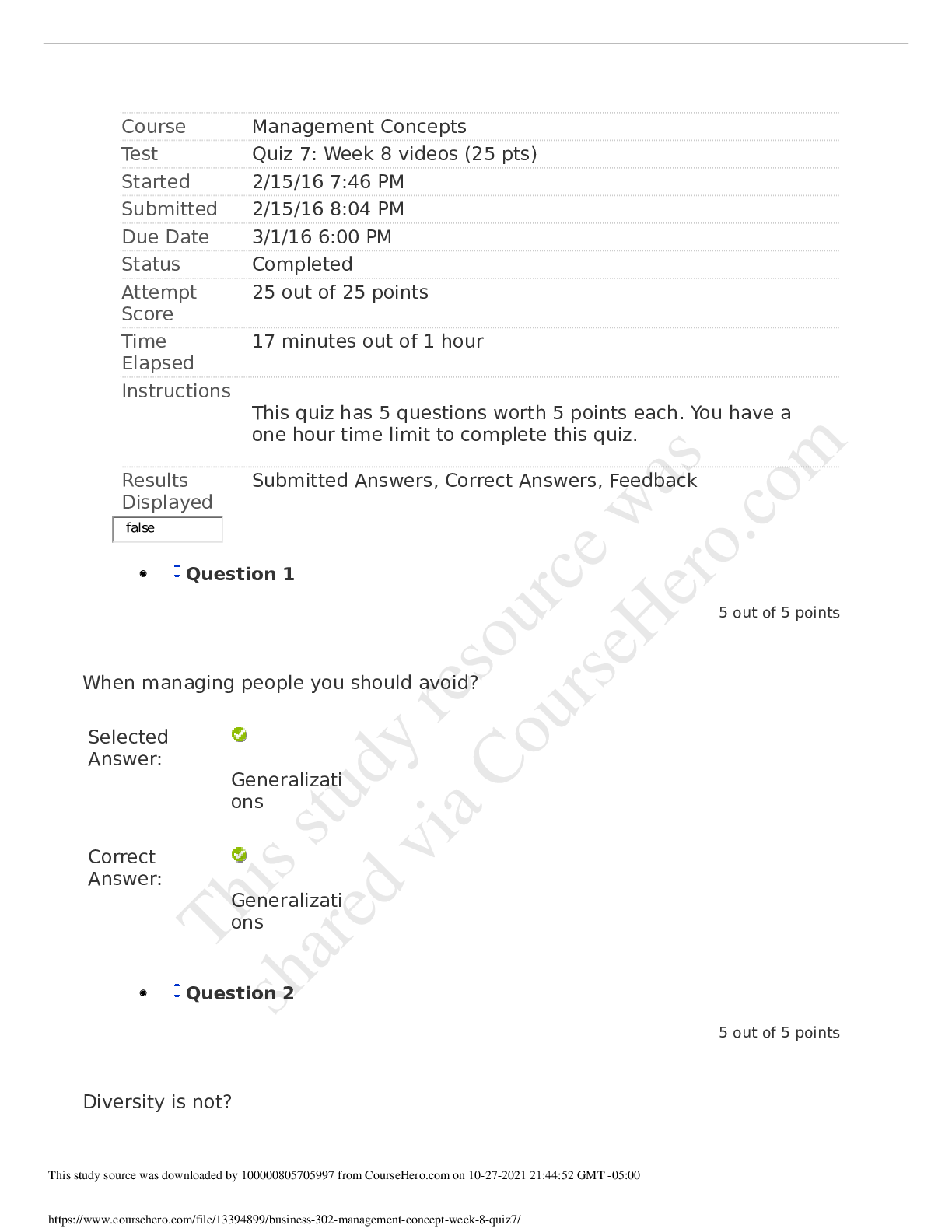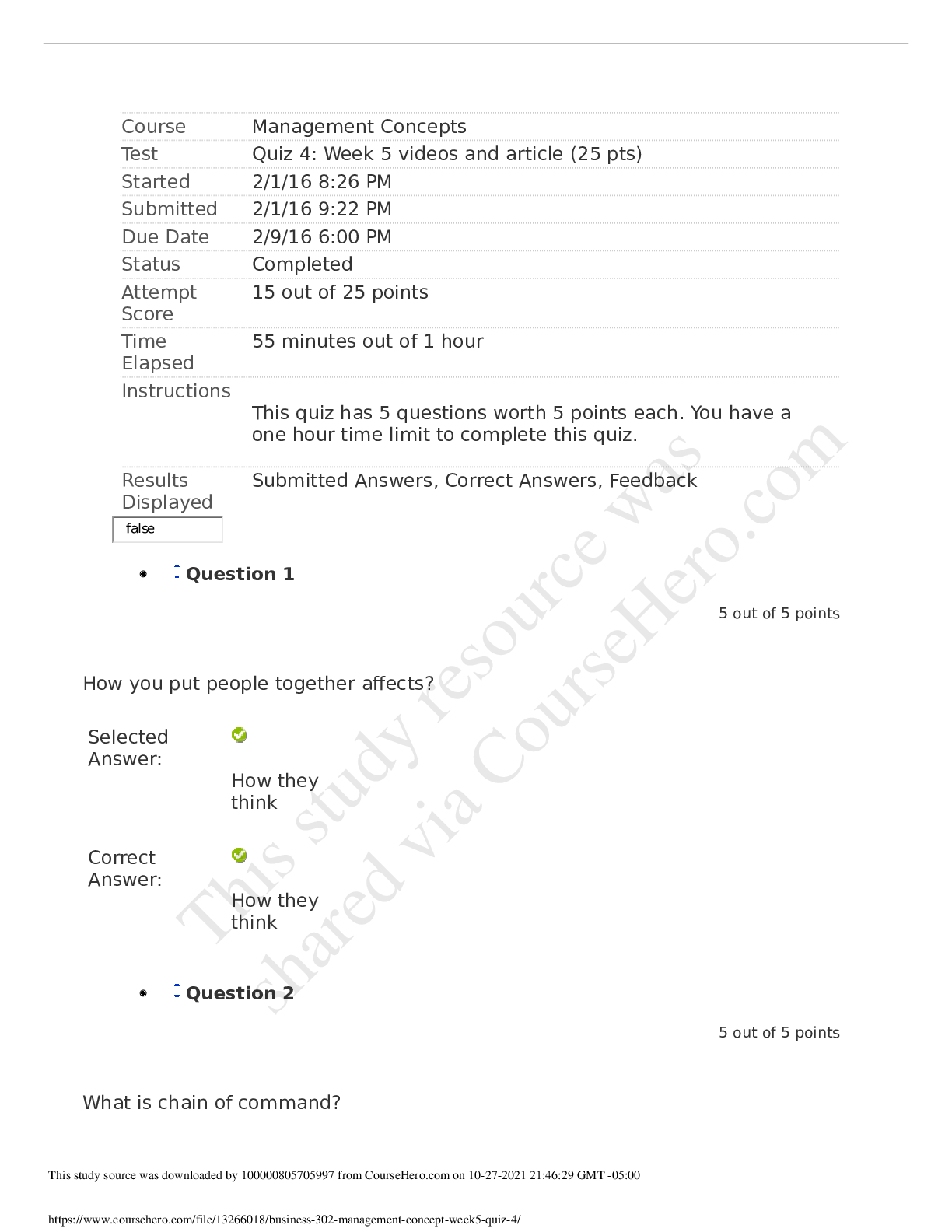Education > QUESTIONS & ANSWERS > Test Bank Chapter 20 Accounting for Pensions and Postretirement Benefits. (All)
Test Bank Chapter 20 Accounting for Pensions and Postretirement Benefits.
Document Content and Description Below
Test Bank Chapter 20 Accounting for Pensions and Postretirement Benefits. CHAPTER 20 ACCOUNTING FOR PENSIONS AND POSTRETIREMENT BENEFITS IFRS questions are available at the end o... f this chapter. TRUe-FALSe—Conceptual Answer No. Description F 1. Funded pension plan. T 2. Qualified pension plans. F 3. Defined-contribution plan liability. T 4. Defined-benefit plans. T 5. Vested benefit obligation. F 6. Accumulated benefit obligation. F 7. Definition of service cost. T 8. Definition of interest cost. F 9. Recognizing accumulated benefit obligation. T 10. Pension Asset /Liability balance. F 11. Plan amendment and projected benefit obligation increase. F 12. Years-of-service amortization method. T 13. Expected return and actual return. F 14. Unexpected gains and losses. T 15. Accumulated OCI (G/L) account and the corridor. F 16. Amortization of net gains and losses. T 17. Recording prior service cost. F 18. Reporting accumulated OCI (PSC) on the balance sheet. F 19. Other comprehensive income (PSC) and net income. T 20. Reconciliation of PBO and fair value of plan assets. Multiple Choice—Conceptual Answer No. Description d 21. Factors considered by actuaries. c 22. Process of funding a pension plan. d 23. Accounting problems in pension plans. c 24. Nature of a defined-contribution plan. b 25. Nature of a defined-benefit plan. b 26. Defined-contribution plan characteristics. a 27. Accounting for a defined-benefit plan. c 28. Pension obligation measurement using future salaries. a 29. Definition of accumulated benefit obligation. a 30. Projected benefit obligation as a measure of pension obligation. d 31. Alternative measures of the pension obligation. d 32. Characteristics of vested benefits. d 33. Pension funding and pension expense recognition. a 34. Components of pension expense. c 35. Service cost calculated using future compensation levels. b 36. Settlement interest rates. Multiple Choice—Conceptual (cont.) Answer No. Description a 37. Nature of plan assets. b 38. Definition of actual return on plan assets. b 39. Pension Asset / Liability. c 40. Items included in pension expense. a 41. Definition of pension expense. c 42. Recognition of prior service costs. c 43. Amortization of prior service costs. b 44. Amortization methods for prior service costs. a 45. Defined-benefit plan amendment. d 46. Unexpected gains and losses. b 47. Recording gains and losses. a 48. Use of fair value of plan asset. a 49. Gain or loss caused by a plant closing. a 50. Reporting pension asset. d 51. Intangible asset—deferred pension cost. a 52. Identification of a balance sheet account. a 53. Recognition of pension asset. b 54. Disclosures of pension plan information. c 55. Function of Pension Benefit Guaranty Corporation. c *56. Postretirement health care benefits. c *57. Disclosures of postretirement benefits. c *58. Postretirement asset. a *59. Postretirement benefits. c *60. Accrual period. b *61. Expected postretirement benefit obligation. d *62. Recognition of prior service cost. b *63. Item not recognized. *This topic is dealt with in an Appendix to the chapter. Multiple Choice—Computational Answer No. Description d 64. Calculate pension expense. c 65. Calculate pension expense. a 66. Calculate pension expense. b 67. Calculate pension expense. a 68. Determine pension expense. a 69. Determine pension liability to be reported. b 70. Determine amortization of gain / loss. d 71. Calculate pension expense. d 72. Calculate pension expense. b 73. Calculate pension expense. b 74. Calculate actual return on plan assets. a 75. Calculate unexpected gain on plan assets. d 76. Calculate net loss amortization. Multiple Choice—Computational Answer No. Description b 77. Calculate projected benefit obligation balance. c 78. Calculate fair value of plan assets. b 79. Calculate amortization of prior service cost. c 80. Calculate interest cost. b 81. Determine actual return on plan assets. c 82. Calculate the unexpected gain on plan assets. b 83. Determine the corridor. b 84. Calculate amortization of net gain. a 85. Calculate pension asset / liability recognized in the balance sheet. c 86. Calculate pension liability. d 87. Calculate pension liability. c 88. Calculate pension liability. b 89. Calculate amount of intangible asset. d 90. Calculate pension liability. b 91. Determine pension liability to be reported. d 92. Determine pension asset / liability to be reported. d 93. Determine balance of projected benefit obligation. c 94. Determine fair value of plan assets. d 95. Determine pension asset / liability to be reported. a 96. Determine pension liability to be reported. b *97. Calculate postretirement expense. a *98. Calculate postretirement expense. b *99. Calculate postretirement expense. Multiple Choice—CPA Adapted Answer No. Description d 100. Determine the projected benefit obligation. b 101. Nature of interest cost. c 102. Determine pension asset / liability to be reported. d 103. Determine pension asset / liability to be reported. a 104. Calculate pension liability. b 105. Calculate pension liability. Exercises Item Description E20-106 Pension accounting terminology. E20-107 Pension asset terminology. E20-108 Measuring and recording pension expense. Exercises (cont.) Item Description E20-109 Measuring and recording pension expense. E20-110 Additional pension liability. E20-111 Pension reconciliation schedule. E20-112 Pension plan calculations. E20-113 Pension plan calculation and entries. E20-114 Corridor amortization. E20-115 Corridor approach (amortization of net gains and losses.) E20-116 Pension plan calculations and journal entry. *E20-117 Computing and recording postretirement expense. *E20-118 Computing postretirement expense and APBO. PROBLEMS Item Description P20-119 Measuring, recording, and reporting pension expense and liability. P20-120 Measuring and recording pension expense. P20-121 Preparing a pension work sheet. P20-122 Amortization of prior service cost. CHAPTER LEARNING OBJECTIVES 1. Distinguish between accounting for the employer's pension plan and accounting for the pension fund. 2. Identify types of pension plans and their characteristics. 3. Explain alternative measures for valuing the pension obligation. 4. List the components of pension expense. 5. Use a worksheet for employer's pension plan entries. 6. Describe the amortization of prior service costs. 7. Explain the accounting for unexpected gains and losses. 8. Explain the corridor approach to amortizing gains and losses. 9. Describe the requirements for reporting pension plans in financial statements. *10. Identify the differences between pensions and postretirement healthcare benefits. *11. Contrast accounting for pensions to accounting for other postretirement benefits. SUMMARY OF LEARNING OBJECTIVES BY QUESTIONS Item Type Item Type Item Type Item Type Item Type Item Type Item Type Learning Objective 1 1. TF 2. TF 21. MC 22. MC Learning Objective 2 3. TF 4. TF 23. MC 24. MC 25. MC S26. MC S27. MC Learning Objective 3 5. TF 28. MC 30. MC 32. MC 117. E 6. TF 29. MC 31. MC 106. E Learning Objective 4 7. TF 36. MC 64. MC 71. MC 80. MC 107. E 8. TF 37. MC 65. MC 72. MC 81. MC 108. E 33. MC 38. MC 66. MC 73. MC 100. E 109. E 34. MC 39. MC 67. MC 74. MC 101. E 116. E 35. MC 40. MC 68. MC 75. MC 106. E 120. P Learning Objective 5 9. TF 10. TF 41. MC 77. MC 78. MC 121. P Learning Objective 6 11. TF 42. MC 44. MC 79. MC 109. E 122. P 12. TF 43. MC 45. MC 108. E 119. P Learning Objective 7 13. TF 46. MC 82. MC 112. E 120. P 14. TF 75. MC 107. E 119. P 121. P Learning Objective 8 15. TF 48. MC 76. MC 85. MC 112. E 115. E 16. TF 49. MC 83. MC 109. E 113. E 120. P 47. MC 70. MC 84. MC 111. E 114. E Learning Objective 9 17. TF 51. MC 56. MC 89. MC 94. MC 104. MC 120. P 18. TF 52. MC 69. MC 90. MC 95. MC 105. MC 19. TF 53. MC 86. MC 91. MC 96. MC 110. E 20. TF 54. MC 87. MC 92. MC 102. MC 111. E 50. MC 55. MC 88. MC 93. MC 103. MC 119. P Learning Objective *10 57. MC Learning Objective *11 57. MC 59. MC 61. MC 63. MC 98. MC 111. E 118. E 58. MC 60. MC 62. MC 97. MC 99. MC 117. E Note: TF = True-False E = Exercise MC = Multiple Choice P = Problem TRUE-FALSE—Conceptual 1. A pension plan is contributory when the employer makes payments to a funding agency. 2. Qualified pension plans permit deductibility of the employer’s contributions to the pension fund. 3. An employer does not have to report a liability on its balance sheet in a defined-benefit plan. 4. Employers are at risk with defined-benefit plans because they must contribute enough to meet the cost of benefits that the plan defines. 5. Companies compute the vested benefit obligation using only vested benefits, at current salary levels. 6. The accumulated benefit obligation bases the deferred compensation amount on both vested and nonvested service using future salary levels. 7. Service cost is the expense caused by the increase in the accumulated benefit obligation because of employees’ service during the current year. 8. The interest component of pension expense in the current period is computed by multiplying the settlement rate by the beginning balance of the projected benefit obligation. 9. Companies recognize the accumulated benefit obligation in their accounts and in their financial statements. 10. The Pension Asset / Liability account balance equals the difference between the projected benefit obligation and the fair value of pension plan assets. 11. Companies should recognize the entire increase in projected benefit obligation due to a plan initiation or amendment as pension expense in the year of amendment. 12. The FASB requires only the years-of-service method for amortization of prior service cost. 13. The difference between the expected return and the actual return is referred to as the unexpected gain or loss. 14. The unexpected gains and losses from changes in the projected benefit obligation are called asset gains and losses. 15. The Accumulated Other Comprehensive Income (G/L) account is amortized only if it exceeds 10 percent of the larger of the beginning balances of the projected benefit obligation or the market-related plan assets value. 16. If the Accumulated Other Comprehensive Income (G/L) account is less than the corridor, the net gains and losses are subject to amortization. 17. When a company amends its defined benefit plan, and recognizes prior service, the projected benefit obligation is increased to recognize this additional liability. 18. Companies report Accumulated Other Comprehensive Income (PSC) as a liability on the balance sheet. 19. Other Comprehensive Income (PSC) is reported as part of net income. 20. Companies must disclose a reconciliation of how the projected benefit obligation and the fair value of plan assets changed during the year either in their financial statements or in the notes. True-False Answers—Conceptual Item Ans. Item Ans. Item Ans. Item Ans. 1. F 6. F 11. F 16. F 2. T 7. F 12. F 17. T 3. F 8. T 13. T 18. F 4. T 9. F 14. F 19. F 5. T 10. T 15. T 20. T MULTIPLE CHOICE—Conceptual 21. In determining the present value of the prospective benefits (often referred to as the projected benefit obligation), the following are considered by the actuary: a. retirement and mortality rate. b. interest rates. c. benefit provisions of the plan. d. all of these factors. 22. In a defined-benefit plan, the process of funding refers to a. determining the projected benefit obligation. b. determining the accumulated benefit obligation. c. making the periodic contributions to a funding agency to ensure that funds are available to meet retirees' claims. d. determining the amount that might be reported for pension expense. 23. In all pension plans, the accounting problems include all the following except a. measuring the amount of pension obligation. b. disclosing the status and effects of the plan in the financial statements. c. allocating the cost of the plan to the proper periods. d. determining the level of individual premiums. 24. In a defined-contribution plan, a formula is used that a. defines the benefits that the employee will receive at the time of retirement. b. ensures that pension expense and the cash funding amount will be different. c. requires an employer to contribute a certain sum each period based on the formula. d. ensures that employers are at risk to make sure funds are available at retirement. 25. In a defined-benefit plan, a formula is used that a. requires that the benefit of gain or the risk of loss from the assets contributed to the pension plan be borne by the employee. b. defines the benefits that the employee will receive at the time of retirement. c. requires that pension expense and the cash funding amount be the same. d. defines the contribution the employer is to make; no promise is made concerning the ultimate benefits to be paid out to the employees. 26. Which of the following is not a characteristic of a defined-contribution pension plan? a. The employer's contribution each period is based on a formula. b. The benefits to be received by employees are usually determined by an employee’s three highest years of salary defined by the terms of the plan. c. The accounting for a defined-contribution plan is straightforward and uncomplicated. d. The benefit of gain or the risk of loss from the assets contributed to the pension fund are borne by the employee. 27. In accounting for a defined-benefit pension plan a. an appropriate funding pattern must be established to ensure that enough monies will be available at retirement to meet the benefits promised. b. the employer's responsibility is simply to make a contribution each year based on the formula established in the plan. c. the expense recognized each period is equal to the cash contribution. d. the liability is determined based upon known variables that reflect future salary levels promised to employees. 28. Alternative methods exist for the measurement of the pension obligation (liability). Which measure requires the use of future salaries in its computation? a. Vested benefit obligation b. Accumulated benefit obligation c. Projected benefit obligation d. Restructured benefit obligation 29. The accumulated benefit obligation measures a. the pension obligation on the basis of the plan formula applied to years of service to date and based on existing salary levels. b. the pension obligation on the basis of the plan formula applied to years of service to date and based on future salary levels. c. an estimated total benefit at retirement and then computes the level cost that will be sufficient, together with interest expected to accumulate at the assumed rate, to provide the total benefits at retirement. d. the shortest possible period for funding to maximize the tax deduction. 30. The projected benefit obligation is the measure of pension obligation that a. is required to be used for reporting the service cost component of pension expense. b. requires pension expense to be determined solely on the basis of the plan formula applied to years of service to date and based on existing salary levels. c. requires the longest possible period for funding to maximize the tax deduction. d. is not sanctioned under generally accepted accounting principles for reporting the service cost component of pension expense. 31. Differing measures of the pension obligation can be based on a. all years of service—both vested and nonvested—using current salary levels. b. only the vested benefits using current salary levels. c. both vested and nonvested service using future salaries. d. all of these. 32. Vested benefits a. usually require a certain minimum number of years of service. b. are those that the employee is entitled to receive even if fired. c. are not contingent upon additional service under the plan. d. are defined by all of these. 33. The relationship between the amount funded and the amount reported for pension expense is as follows: a. pension expense must equal the amount funded. b. pension expense will be less than the amount funded. c. pension expense will be more than the amount funded. d. pension expense may be greater than, equal to, or less than the amount funded. 34. The computation of pension expense includes all the following except a. service cost component measured using current salary levels. b. interest on projected benefit obligation. c. expected return on plan assets. d. All of these are included in the computation. 35. In computing the service cost component of pension expense, the FASB concluded that a. the accumulated benefit obligation provides a more realistic measure of the pension obligation on a going concern basis. b. a company should employ an actuarial funding method to report pension expense that best reflects the cost of benefits to employees. c. the projected benefit obligation using future compensation levels provides a realistic measure of present pension obligation and expense. d. all of these. 36. The interest on the projected benefit obligation component of pension expense a. reflects the incremental borrowing rate of the employer. b. reflects the rates at which pension benefits could be effectively settled. c. is the same as the expected return on plan assets. d. may be stated implicitly or explicitly when reported. 37. One component of pension expense is expected return on plan assets. Plan assets include a. contributions made by the employer and contributions made by the employee when a contributory plan of some type is involved. b. plan assets still under the control of the company. c. only assets reported on the balance sheet of the employer as prepaid pension cost. d. none of these. 38. The actual return on plan assets a. is equal to the change in the fair value of the plan assets during the year. b. includes interest, dividends, and changes in the market value of the fund assets. c. is equal to the expected rate of return times the fair value of the plan assets at the beginning of the period. d. all of these. 39. In accounting for a pension plan, any difference between the pension cost charged to expense and the payments into the fund should be reported as a. an offset to the liability for prior service cost. b. pension asset/liability. c. as other comprehensive income (G/L) d. as accumulated other comprehensive income (PSC). 40. Which of the following items should be included in pension expense calculated by an employer who sponsors a defined-benefit pension plan for its employees? Amortization of Fair value prior of plan assets service cost a. Yes Yes b. Yes No c. No Yes d. No No 41. A corporation has a defined-benefit plan. A pension liability will result at the end of the year if the a. projected benefit obligation exceeds the fair value of the plan assets. b. fair value of the plan assets exceeds the projected benefit obligation. c. amount of employer contributions exceeds the pension expense. d. amount of pension expense exceeds the amount of employer contributions. 42. When a company adopts a pension plan, prior service costs should be charged to a. accumulated other comprehensive income (PSC). b. operations of prior periods. c. Other comprehensive income (PSC). d. retained earnings. 43. When a company amends a pension plan, for accounting purposes, prior service costs should be a. treated as a prior period adjustment because no future periods are benefited. b. amortized in accordance with procedures used for income tax purposes. c. recorded in other comprehensive income (PSC). d. reported as an expense in the period the plan is amended. 44. Prior service cost is amortized on a a. straight-line basis over the expected future years of service. b. years-of-service method or on a straight-line basis over the average remaining service life of active employees. c. straight-line basis over 15 years. d. straight-line basis over the average remaining service life of active employees or 15 years, whichever is longer. 45. Whenever a defined-benefit plan is amended and credit is given to employees for years of service provided before the date of amendment a. both the accumulated benefit obligation and the projected benefit obligation are usually greater than before. b. both the accumulated benefit obligation and the projected benefit obligation are usually less than before. c. the expense and the liability should be recognized at the time of the plan change. d. the expense should be recognized immediately, but the liability may be deferred until a reasonable basis for its determination has been identified. 46. The actuarial gains or losses that result from changes in the projected benefit obligation are called A [Show More]
Last updated: 1 year ago
Preview 1 out of pages

Buy this document to get the full access instantly
Instant Download Access after purchase
Add to cartInstant download
We Accept:

Reviews( 0 )
$12.00
Document information
Connected school, study & course
About the document
Uploaded On
Nov 03, 2020
Number of pages
Written in
Additional information
This document has been written for:
Uploaded
Nov 03, 2020
Downloads
0
Views
5











